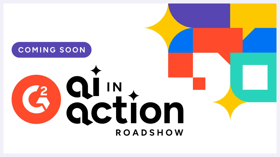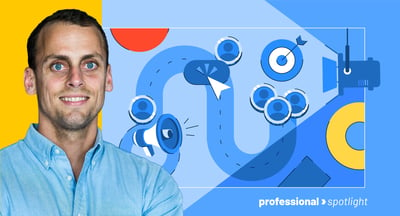May 7, 2025
 by Kamaljeet Kalsi / May 7, 2025
by Kamaljeet Kalsi / May 7, 2025

What’s one thing every marketing leader and athlete agrees on? That short-termism is the enemy of sustainable performance and success has no shortcuts.
Life influences work, and experiences shape the way we lead. So, what happens when an Olympic track hopeful turns marketing visionary? You get Tyrona Heath, a leader who blends strategic sharpness with human empathy, reminding us that B2B marketing isn’t just about metrics but about meaning.
As director and co-founder of LinkedIn’s think tank, The B2B Institute, Tyrona Heath is reshaping how the industry thinks about brand, behavioral science, and the future of AI-powered storytelling.
Her message is clear: run your own race and make it unforgettable. If you’re looking for ways to rise above the sea of B2B sameness, dive in and learn creative, data-backed strategies to make your brand memorable using AI and behavioral insights.
This interview is part of G2’s Professional Spotlight series. For more content like this, subscribe to G2 Tea, a newsletter with SaaS-y news and entertainment.
What's your favorite beverage?
I'd have to say it's a tie between two. First, coffee — I basically keep it on tap! I just love the taste, and with my Jamaican roots, I make it with condensed milk. Then there's bubble tea. I’m obsessed with the texture of the pearls. There’s one version with a burnt caramel flavor that’s just incredible. For me, it's really the little details, the texture, that rich caramel taste, that make them my favorites.
What was your first job?
My mom’s a nurse, so I got introduced to healthcare early on. My first job was actually as a candy striper. I don’t think they call it that anymore, but back then, you basically went in and supported the hospital staff however you could.
The part I loved the most wasn’t just helping with tasks. It was the conversations. Just spending a few minutes talking to patients, sharing a genuine smile, and helping brighten their day. A lot of them were going through tough moments, and I realized how much human connection mattered.
That experience stayed with me. It taught me that even small gestures can make a big difference.
What's your favorite software in your current tech stack?
We already know what I'm going to say — it’s LinkedIn. Without question. And honestly, it's not just because I work there. Even before I joined LinkedIn and co-founded The B2B Institute, it was my favorite social network. It’s where I built genuine relationships and forged real collaborations. It’s also where I get to share about marketing science and actually watch it come to life across the ecosystem.
I call LinkedIn the conversation before the conversation. Before people even meet you, they’re likely searching for your name, and most of the time, LinkedIn is what pops up first. It’s such an important place to tell your story, be helpful, and learn from others.
I’ve also been loving Stan. As a digital creator, it’s becoming a real game-changer for making marketing education more accessible. When you’re obsessed with connecting dots the way I am, having platforms that bridge the gap between insight and action is invaluable.
What problems at work make you want to throw your laptop out the window?
I promise no laptops have been harmed, it’s all happening internally! What really tests my patience are the tasks that are necessary but not really needle-moving. You know, the busy work. As someone who loves deep work, especially being part of a think tank, my brain pretty much stages a mini protest when I can't dive deep into something meaningful.
Give me a meaty research paper or a complex marketing problem to dissect, and I’m like a kid in a candy store. I'm really fortunate because my role at The B2B Institute gives me the space to nerd out with brilliant minds and dig into marketing science.
And for those less thrilling tasks? I'm hopeful that’s where AI can step in and help us out. Technology is finally catching up to our collective need for more deep work!
Quick story. Before I even moved into tech, I was running track competitively, training to try out for the Olympics. That brought me out to Silicon Valley, where I joined the Nike Farm Team as a sponsored runner.
It was serendipitous, really, because being out there led to my first exposure to the tech world — and to marketing. I landed a role at Google, and that's where I had this lightbulb moment. I realized marketing isn’t just about campaigns or ads; it's about moving people, helping them make decisions. Before that, I had actually been thinking about a career in government or politics because I was fascinated by how messages influence people, and marketing turned out to be a perfect parallel.
I stayed in marketing, got my MBA, and even started running a small agency literally out of a closet in my MBA program office. It was a challenging but incredibly rewarding time. I had to be a marketer and deliver leads, but also deeply understand what marketers were struggling with day to day.
Then, a few years later when I joined LinkedIn’s Agency and Partner business, the idea for The B2B Institute came about with three other colleagues. There was a need for a broader conversation around the value and long-term investment in brand building. We had been answering customer questions like, "Where’s the market headed? What trends should we be paying attention to?" It was through those discussions that we realized brand building could be one of the biggest competitive advantages for businesses.
We're essentially running a B2B university inside a tech company. We're making marketing science less like quantum physics and more like your favorite Netflix show — digestible, engaging, and occasionally funny.
Turns out my ambassador dreams weren't so far off. I'm just advocating for better B2B marketing instead of international relations.
At The B2B Institute, we're on a mission to help marketers see the long-term value of investing in their brand. We’ve been on this journey for over six years now, exploring how marketers can create more value through brand investment, and it's been an incredibly rewarding ride.
You’ve mentioned being an athlete and trying for the Olympics. How has your experience of being a sports person enriched your career and leadership style?
The 800 meters is one of the most brutal races out there — a full-out sprint for two minutes. But I loved it because it’s a fascinating blend of strategy and split-second decisions. I didn’t even like the 800 at first, but over time, I learned that it was a perfect parallel to business.
In both the race and in marketing leadership, there’s a balance between the long game and staying sharp to seize opportunities.
In track, you also have to manage yourself under immense pressure. I remember competing at events like the Olympic Trials or Penn Relays with 40,000 people in the stands watching. The pressure is unreal.
The real lessons come not just from spotlight moments, but from showing up at 5 AM for workouts when no one’s watching, trusting that the consistency compounds and will pay off.
Another big lesson was about failure and setbacks. I didn’t win every race, but what I learned was to pick myself up, analyze what went wrong, and apply that learning to the next race. In sports, just like in business, success isn’t linear. The key is how quickly you get back up, and how you help others do the same.
“Leadership isn’t about individual heroics; it’s about creating an environment where everyone pushes toward the same finish line.”
Tyrona Heath
Co-founder and Director of LinkedIn's B2B Institute
Whether you're passing the baton in a relay or passing insights to your team, everyone's contribution matters to the outcome.
And here’s the kicker: sometimes, your biggest breakthroughs come right after you’re ready to throw in the towel. That’s when you discover the difference between a setback and a setup for something better.
What are some noteworthy experiences that have shaped you as a Black woman in tech?
I once read a Harvard Business Review article that really stuck with me. It described the experience of being a Black woman in tech as walking a tightrope, where you're highly visible and invisible at the same time. It’s a paradox that captures a lot of what many of us feel: the margin for error can be razor-thin.
But over time, that tightrope has become my runway. I’ve been fortunate to have mentors like Stacy Brown-Philpot, whom I met during my time at Google. She showed me what leadership can look like and how to lead with both strength and grace. Mentorship like that is invaluable, not just for me but for so many Black women navigating spaces where we’ve been historically excluded.
When I joined LinkedIn, I saw an opportunity to create something bigger than myself. That’s part of why I served as President of LinkedIn’s Black Inclusion Group and helped launch TransformHer, a platform and event series that invests in women of color and builds a community of active allies. Because the truth is, no one reaches the summit alone. Community is everything.
And through our work at the B2B Institute, especially our Equity Every Day research, I’ve been reminded just how powerful media and storytelling really are. They help people see each other’s truth. They help us confront bias and expand empathy. And when we do that, we’re not just telling better stories, we’re shaping a better reality. We’re not just climbing the ladder. We’re making sure it stays up for the next generation.
What are some challenges and concerns you’re seeing in advertising? Is AI aiding or affecting advertisers?
The biggest challenge I see, especially in B2B, is short-termism. It’s like we’re stuck on a sugar rush, constantly chasing the next click or metric while forgetting the long game. The typical B2B sales cycle is nine months, yet we’re measuring success like it should show up in nine minutes. That kind of pressure skews how we think about brand building.
Now with AI and real-time analytics in the mix, that urgency is amplified. There’s an expectation that every campaign should prove its worth instantly. But marketing isn’t a sprint. It’s a marathon. And when we judge the entire race by the first 100 meters, we miss the bigger picture.
What we need is a return to balanced marketing. Yes, performance metrics matter. But they should live alongside long-term investments in the brand — the kind that builds trust, differentiation, and staying power. That’s where AI can help: not by fueling the click-chase, but by helping us understand what really moves the needle over time.
The companies that are thriving right now? They’re the ones brave enough to resist the urge for instant gratification. They’re betting on brand, using AI to uncover real insights, and focusing on building value quarter after quarter. That’s where the magic happens.
AI isn’t just changing advertising outcomes — it’s reshaping the way marketers work.
At LinkedIn, Tyrona Heath points to Accelerate, an AI-powered campaign tool that dramatically streamlines the ad creation process. LinkedIn Accelerate turns what used to be a four-hour campaign setup marathon into a 15-minute sprint, while boosting return-on-investment (ROI) by 42% compared to classic campaigns.
Whether it’s helping marketers launch campaigns faster or generating content suggestions for a LinkedIn post, AI is becoming a co-pilot that removes friction and helps professionals take the first step with more confidence.
In 2024, you mentioned that 81% of B2B ads that came from a lucrative $30 billion annual spend failed to capture attention. What’s your contrarian view of what will make advertising sticky in 2025?
Maybe it’s not so contrarian after all, but here it is: being forgettable is the riskiest strategy in B2B. We’re living in a sea of sameness.
In our Better, Bolder Branding research, we found that in the cloud computing space, only 5.75% of people could correctly match brand colors. That means 94% of the time, you're running ads for your competitors. It’s like showing up to prom in the same outfit as your rival — awkward, and entirely avoidable.
“The future belongs to the bold. Brands won’t break through by playing it safe. We need more personality. More distinctiveness. More brand characters, only 1% of B2B ads use them, yet they drive 6x more attention.”
Tyrona Heath
Co-founder and Director of LinkedIn's B2B Institute
We need memorable brand assets. We need jingles (yes, even in B2B!). Because when everything looks and sounds the same, you're not just blending in, you’re disappearing.
If there's one rule for 2025, it’s this: don’t be forgettable.

Join industry leaders at G2's free AI in Action Roadshow for actionable insights and proven strategies to reimagine your funnel. Register now
Would you like to share any insights about wielding behavioral science in B2B advertising?
Shout out to Rory Sutherland, who’s been championing this for years, but —
“Here’s a provocative truth: marketers are essentially memory architects, yet most of us are building without a blueprint.”
Tyrona Heath
Co-founder and Director of LinkedIn's B2B Institute
We’re spending millions on ads and media plans, but pennies on understanding how memory and emotion actually influence decision-making. It’s like being a chef who never studied taste buds or a DJ who skipped the lesson on how ears work. We have this incredible power to shape perception, but we’re still largely flying blind when it comes to how humans really decide.
Behavioral science reminds us that even in B2B, decisions aren’t purely rational; they’re deeply emotional. People buy based on how they feel, and then they justify those decisions logically. But too often, we’re still creating campaigns that feel like they’re made for spreadsheets instead of actual people.
What if we flipped the script? What if we invested as much in understanding the brain as we do in optimizing for clicks? Because even the smartest AI-driven campaign won’t matter if it doesn’t stick in someone’s memory when they’re making a big decision nine months later.
In a world of noise, memorability is everything, and behavioral science gives us the tools to design for that.
How do you foresee the pair up of AI, data storytelling and behavioral science performing in the near future?
We’re entering a fascinating era where AI isn’t just crunching numbers, it’s helping us decode human behavior at scale. Think about it: AI can now surface buying patterns across complex committees that would take a human team months or even years to untangle. But the real breakthrough is what happens when you combine that pattern recognition with behavioral science — it’s not just better data but better stories about what that data means.
For instance, we’re starting to see AI tools that don’t just track engagement but also map entire micro-behavior journeys that reveal real buying intent. Suddenly, we can understand buying committees not as static org charts, but as dynamic ecosystems, constantly shifting and signaling in subtle ways.
Here’s my spicy take: the winners in this next chapter won’t be the ones with the most AI or the biggest data lake; they’ll be the ones who can humanize what they see. The ones who use AI and behavioral science to uncover the emotional cues, motivations, and tensions behind the numbers.
Because even in our AI-powered future, B2B buying decisions are still made by humans — humans looking for certainty, connection, and confidence.
The magic won’t come from prediction alone. It’ll come from those who can translate insight into empathy and can turn patterns into powerful, human-centered stories.
What’s one piece of wisdom you’d like to pass down to future women in (tech) leadership positions?
Here’s what I wish someone had told me earlier: Ask yourself, “Why not you?” It sounds simple, but it’s a powerful reframe.
“Too often, especially in tech, we waste energy second-guessing whether we’re ready, qualified, or “next in line.” Instead, start asking: Why not me? Why not now?”
Tyrona Heath
Co-founder and Director of LinkedIn's B2B Institute
Betting on yourself doesn’t mean being reckless. It means choosing to honor your values, your voice, and the one precious life you’ve been given. Some of my biggest breakthroughs came when I stopped waiting for permission and started giving myself the green light.
And remember: every leader you admire once stood exactly where you are, asking the same questions. The difference? They answered “why not me?” with “watch me work.”
Subscribe to G2 Tea, our SaaS-y newsletter with brand marketing insights and leadership strategies from industry professionals like Ty!
Follow Tyrona Heath on LinkedIn to learn more about her B2B marketing endeavors.
Edited by Supanna Das
Kamaljeet Kalsi is Sr. Editorial Content Specialist at G2. She brings 9 years of content creation, publishing, and marketing expertise to G2’s TechSignals and Industry Insights columns. She loves a good conversation around digital marketing, leadership, strategy, analytics, humanity, and animals. As an avid tea drinker, she believes ‘Chai-tea-latte’ is not an actual beverage and advocates for the same. When she is not busy creating content, you will find her contemplating life and listening to John Mayer.
Most B2B marketers think buyers are rational first and emotional later. They are wrong.
 by Sidharth Yadav
by Sidharth Yadav
Data-driven storytelling is at the heart of winning customer love. But like Cupid’s arrow, it...
 by Kamaljeet Kalsi
by Kamaljeet Kalsi
Which marketing strategies truly drive precious sales? As a B2B marketer, you always have this...
 by Soundarya Jayaraman
by Soundarya Jayaraman
Most B2B marketers think buyers are rational first and emotional later. They are wrong.
 by Sidharth Yadav
by Sidharth Yadav
Data-driven storytelling is at the heart of winning customer love. But like Cupid’s arrow, it...
 by Kamaljeet Kalsi
by Kamaljeet Kalsi


